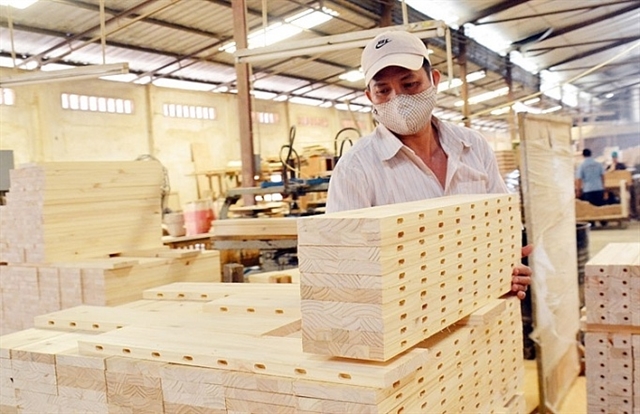 Economy
Economy

 |
| Việt Nam's export value of wood and forest products in the first seven months of 2023 was estimated at US$7.78 billion. — Photo congthuong.vn |
HÀ NỘI — The State will remove difficulties to achieve the export target of timber and forest products this year, Nguyễn Quốc Trị - Deputy Minister of Agriculture and Rural Development said at a recent conference on processing and export of wood and forest products in 2023 held in Bình Dương Province.
At present, there are signs of economic recovery in the import markets of Việt Nam's timber and wood products, such as the US.
To achieve the export value target of US$17 billion this year, Trị has requested the Administration of Forestry and the Việt Nam Timber and Forest Products Association (Viforest) to update wood processing facilities in craft villages on legal timber policies and regulations, the trend of using environmentally friendly products, as well as the new EU regulations on deforestation-linked products.
The State management agencies need to review and cut administrative procedures, and perfect institutions and policies to create favourable conditions for the import and development of wood materials from domestically planted forests with sustainable forest management certification.
The Administration of Forestry and Viforest should enhance coordination with relevant ministries and sectors to remove difficulties of wood processing and forest product exporting enterprises.
They should support enterprises to improve their capacity of responding to trade defence cases, and minimise the impact of the lawsuits. Now, the wood industry faces anti-dumping investigations against plywood, kitchen cabinets and dressing tables exported to the US.
The Administration of Forestry under the Ministry of Agriculture and Rural Development reported that the export value of wood and forest products in the first seven months of 2023 was estimated at $7.78 billion, down 25.5 per cent over the same period in 2022.
Among products, timber and wood products saw a decline in export value of 26.2 per cent to $7.21 billion, while the export value for non-timber forest products reached $580 million, down 15.4 per cent.
The US, Japan, China, the EU and South Korea continued to be the main export markets for Vietnamese timber and forest products.
Total export value to the five markets in the first seven months of 2023 was estimated at $5.44 billion, accounting for 89 per cent of the country's total export value.
Of which, the export revenue was $3.1 billion to the US, down 39.8 per cent, $834.3 million to Japan, down 4.8 per cent, $701.1 million to China, down 26.3 per cent, $425.5 million to the EU (including UK), down 33.7 per cent, and $410.3 million to South Korea, down 24.9 per cent.
The industry also saw strong reduction in export prices of some key products. The export price decreased to $135 per tonne of wood chips in the first seven months of 2023 from $195 in 2022; and to $100 per tonne of wood pellet from $180 last year.
Triệu Văn Lực, deputy director of the Administration of Forestry, said that the strong decrease in export value in the first seven months of 2023 was due to high inflation in some key exporting countries including the US and the EU. Those countries have issued many tightening monetary policies, while consumers have also reduced spending for non-essential products, including wooden products.
Meanwhile, the Russia-Ukraine conflict continues affecting production and business activities of enterprises, including increases in logistic costs, and prices of all raw materials and inputs for production.
Protection policies of other countries also continue to be promoted to support for domestically produced products, thus affecting the export of wood products from Việt Nam.
Some craft villages have difficulty in finding markets for products as well as converting to using raw timber from planted forests and legally originated timber imports.
Đỗ Xuân Lập, Viforest chairman, said the export turnover of domestic and FDI enterprises both decreased compared to the same period in 2022.
Meanwhile, the enterprises have so far not received notice of interest rate reduction for old loans, although the Government has urged commercial banks to reduce interest rates of loans for businesses. The banks now have cut interest rates for only new loans.
Regarding the credit limit, depending on the reputation and orders of the business, the banks have different credit limits. In addition, the banks only provide loans after assessing the risk of the enterprises' orders, Lập said.
For value-added tax refund, the situation of delayed tax refund for wood enterprises have not been significantly improved.
Besides that, exporting enterprises still have difficulties in getting verification of wood origin according to regulations, leading to many obstacles in the process of receiving certificates of origin (C/O) for export products.
Lập suggested that the Ministry of Agriculture and Rural Development hold negotiations with importing countries to set up united regulations on timber traceability for Việt Nam's export wood products.
At the same time, it is necessary to pilot a green development model for wood processing enterprises, towards the net zero commitment in the wood industry.
Regarding the opening of the market, Lập proposed that the Government, ministries and agencies direct diplomatic missions abroad to strengthen support for the import-export businesses by promoting Việt Nam's export wood products to foreign countries, focusing on potential markets that lack information about Vietnamese wood products.
The Ministry of Finance is requested to coordinate with the Ministry of Agriculture and Rural Development and the Ministry of Industry and Trade to organise conferences with wood exporting enterprises to find solutions removing difficulties in VAT refund and verification on origin of timber from domestically planted forests. — VNS




